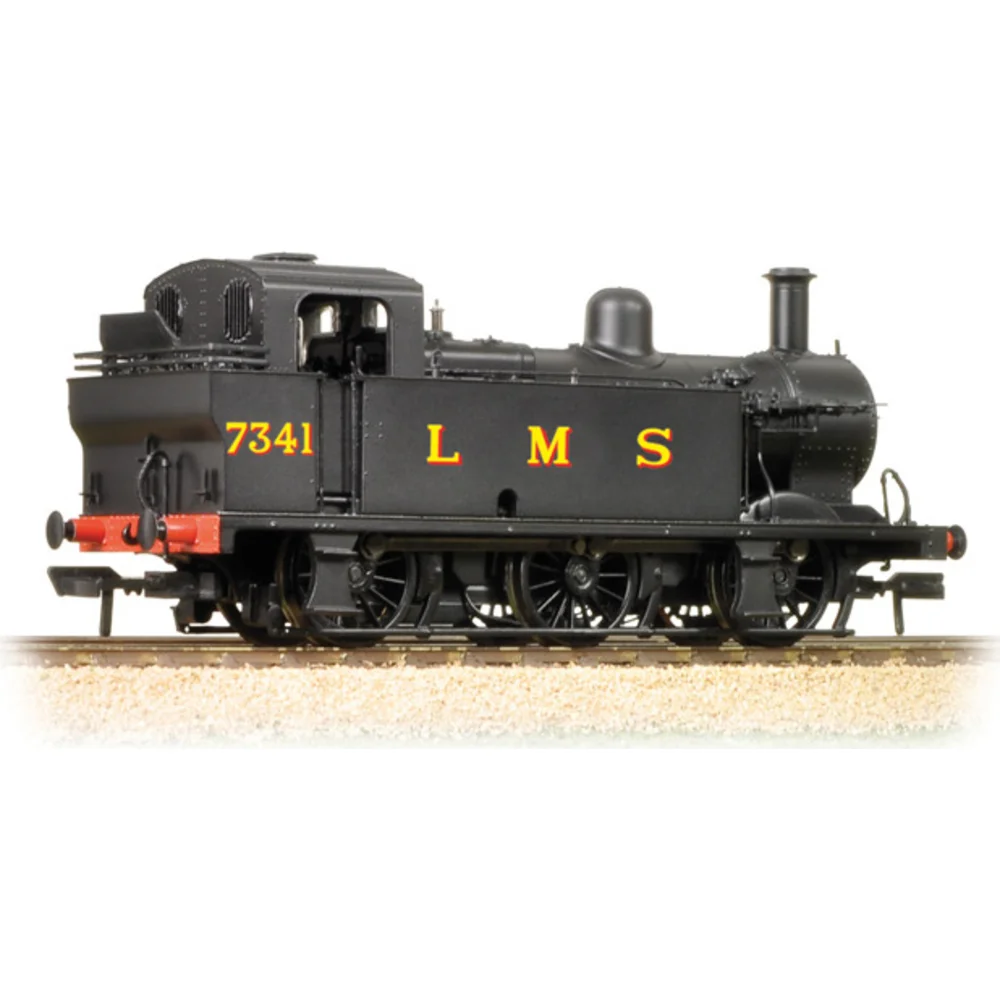Bachmann 32-227B
London, Midland & Scottish Railway 3F 7341 London, Midland & Scottish Railway Black
Tooling
In 2004, Bachmann Branchline introduced a completely new tooling for the LMS Class 3F “Jinty” 0-6-0T in OO gauge, replacing older, less detailed models from other manufacturers. This release marked a significant leap forward in accuracy and detailing for small tank locomotives, setting new standards for ready-to-run British outline models.
Tooling Features
- Scale: OO gauge (1:76.2), designed for 16.5 mm track.
- Construction: High-quality plastic bodyshell with diecast chassis for strength and weight.
- Detailing: Separately fitted handrails, lamp irons, vacuum pipes, sprung buffers, and fully detailed cab interior with painted backhead. Glazing and footplate doors included.
- Couplings: NEM pockets with tension-lock couplers supplied.
Mechanical & Electrical
- Motor & Drive: Smooth-running 3-pole skew-wound can motor mounted in the chassis, driving all three axles via a gear train.
- Minimum Radius: Suitable for 2nd radius curves (approx. 438 mm).
- Weighting: Integrated diecast components for improved adhesion.
- Lighting: No factory lighting on this tooling.
DCC Capability
Early releases were DCC compatible but not socketed, requiring hard-wiring for digital conversion. Later iterations (post-2011) introduced an 8-pin socket, and recent reissues feature Next18 sockets with sound capability.
Liveries Produced
The 2004 tooling appeared in a wide range of authentic schemes, including:
- LMS Black (lined and unlined)
- LMS Crimson Lake (limited editions)
- BR Black (early and late crests)
- Special editions such as S&DJR blue and NCC black
Reviews & Commentary
Upon release, the Jinty was praised in the model railway press for its fine detailing, smooth running, and accurate proportions. Reviewers highlighted the cab detail and separately fitted components as standout features. Social media and forum discussions from the time noted its reliability and ease of conversion to DCC, though some enthusiasts wished for factory-fitted sockets earlier.
Interesting Notes
- The tooling anticipated future upgrades, with space for a 23 mm round speaker in later chassis designs.
- This model represented a major improvement over older Tri-ang/Hornby versions, which lacked separate detailing and accurate dimensions.
Class & Prototype
- Class: London, Midland & Scottish Railway 3F
- Traction: Steam
- Built: 1924-1931
- Total Built: 422
- Running Number: 7341
Operator & Livery
- Operator: London, Midland & Scottish Railway
- Livery: Black
- Era: 3 - The big 4 – LMS, GWR, LNER & SR
The London, Midland & Scottish Railway (LMS) was Britain's largest railway company from 1923-1948, formed by merging over 120 independent railways under the Railways Act 1921. Operating 7,790 route miles across England, Scotland, Wales, and Northern Ireland, the LMS became the world's largest transport organisation and the British Empire's biggest commercial enterprise. Famous for iconic locomotives like the streamlined Princess Coronation class, versatile Black Fives, and Royal Scots, the company evolved from inherited pre-grouping designs to revolutionary Stanier innovations. The LMS operated major routes including the West Coast Main Line from London Euston to Scotland, serving as the UK's second-largest employer after the Post Office. Nationalised in 1948 to form British Railways' London Midland Region, the LMS legacy continues through extensive preservation efforts and remains a favourite subject for railway modellers seeking authentic British steam-age prototypes.
The LMS plain black livery served as the standard finish for freight locomotives and represented practical railway economics during the company's existence. Applied without lining or embellishment, this utilitarian scheme recognised that goods engines operated in inherently dirty conditions where elaborate paintwork proved both expensive and impractical.
Most LMS freight classes including the ubiquitous 0-6-0 goods engines, 0-8-0 heavy freight locomotives, and tank engines used for shunting duties wore plain black throughout their service lives. The scheme extended beyond locomotives to goods wagons, where black paint provided adequate weather protection at minimal cost.
During World War II, plain black became increasingly common as material shortages and wartime economies forced the abandonment of more elaborate liveries. Even some passenger locomotives temporarily adopted unlined black finishes when crimson lake supplies became unavailable. The practical benefits of black paint - its ability to hide dirt, soot, and industrial grime - made it ideal for locomotives working coal trains, mineral traffic, and heavy industrial duties.
For modellers, plain black represents the workhorse reality of LMS operations, particularly appropriate for freight yards, colliery branches, and industrial settings where authentic weathering and operational realism take precedence over passenger train glamour.
